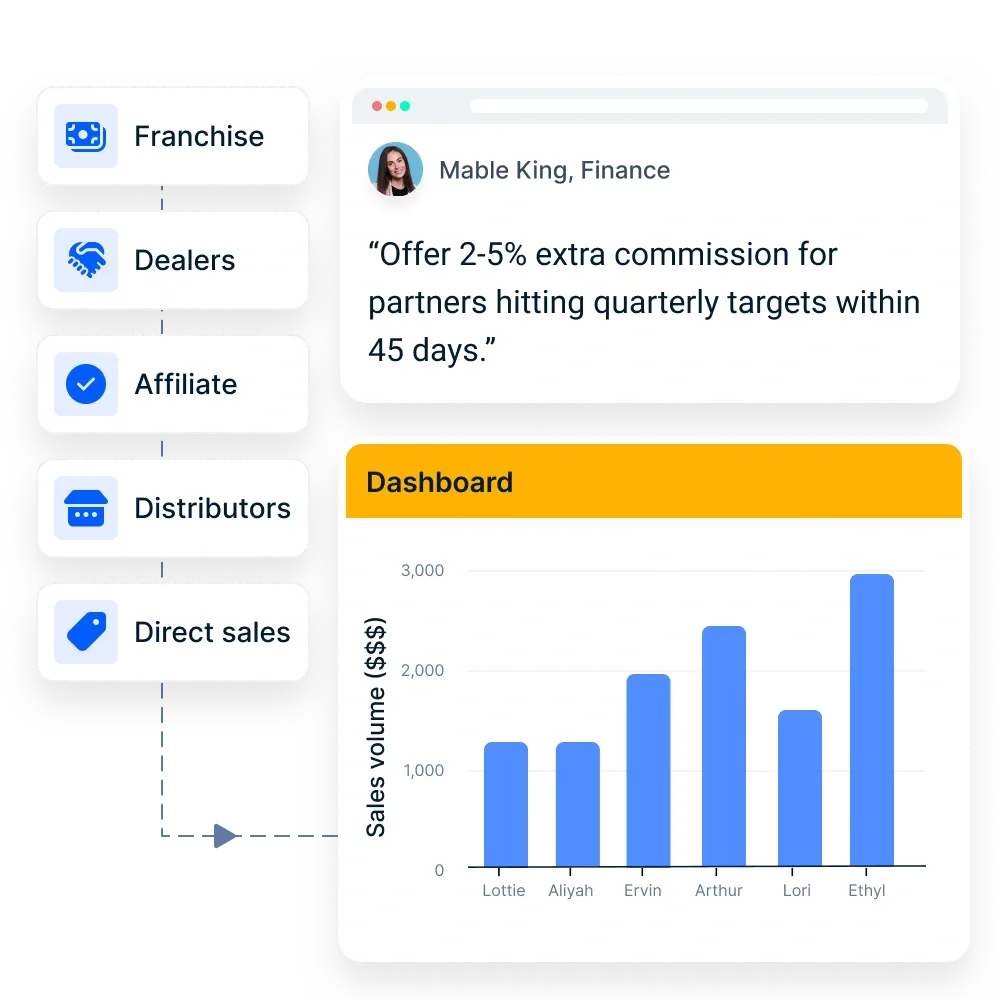5 Strategien zum Management von Vertriebspartnern für Wachstum und Erfolg
Die Verwaltung von Vertriebspartnern ist für Unternehmen von entscheidender Bedeutung, wenn es darum geht, den Umsatz zu steigern, die Kundenzufriedenheit zu erhöhen und enge Beziehungen zu den Partnern aufzubauen.
Auf dieser Seite
Das Management von Vertriebspartnern ist das Rückgrat eines erfolgreichen Geschäftswachstums, doch viele Unternehmen übersehen sein Potenzial. Mit über 70% der Unternehmen verlassen sich auf Vertriebspartner, um ihren Umsatz zu steigern. Ein effektives Management dieser Beziehungen ist daher entscheidend für die Maximierung der Leistung und das Erreichen strategischer Ziele.
Ein gut strukturiertes Programm für Vertriebspartner verbessert nicht nur die Zusammenarbeit, sondern fördert auch die Loyalität und Innovation und macht aus Partnern starke Verbündete.
Dieser Blog befasst sich mit wichtigen Strategien für das Management von Vertriebspartnern. Wir erforschen umsetzbare Erkenntnisse, die Ihre Partnerschaften zu neuen Höhenflügen verhelfen können.
Was ist ein Vertriebspartner und wie viele Arten von Partnerschaften gibt es?
Vertriebspartner sind Drittanbieter oder Organisationen, die mit einem Unternehmen zusammenarbeiten, um dessen Produkte oder Dienstleistungen zu fördern und zu verkaufen. Sie spielen eine entscheidende Rolle in einem erfolgreichen Vertriebspartnerprogramm, da sie Unternehmen dabei helfen, ihre Kunden über verschiedene indirekte Vertriebskanäle.
Diese Partnerschaften können verschiedene Formen annehmen, die jeweils einzigartige Vorteile und Verwaltungsstrategien mit sich bringen. Im Folgenden werden die Arten von Vertriebspartnerschaften beschrieben:
Wiederverkäufer: Diese Partner kaufen Produkte von einem Unternehmen und verkaufen sie an Endkunden. Sie verfügen oft über einen festen Kundenstamm und können helfen, schnell in neue Märkte einzudringen.
Vertriebshändler: Als Vermittler kaufen Händler Produkte in großen Mengen von den Herstellern und vertreiben sie an Einzelhändler oder andere Unternehmen, wodurch sie einen breiteren Marktzugang ermöglichen.
Affiliate-Partner: Diese Partner bewerben die Produkte oder Dienstleistungen eines Unternehmens über ihre Marketingkanäle und erhalten dafür eine Provision auf die Verkäufe generiert. Sie sind besonders effektiv bei Lead-Generierung und zur Steigerung der Markenbekanntheit.
Empfehlungspartner: Diese Partner verweisen potenzielle Kunden an ein Unternehmen und erhalten oft eine Gebühr oder Provision für erfolgreiche Konversionen. Sie können beim Aufbau von Vertriebspartnerbeziehungen, die den gegenseitigen Erfolg fördern, eine wichtige Rolle spielen.
Dienstleistungsanbieter: Unternehmen, die ergänzende Dienstleistungen anbieten, können ebenfalls als Vertriebspartner betrachtet werden. So kann beispielsweise ein Softwareunternehmen mit IT-Dienstleistern zusammenarbeiten, um den Kunden integrierte Lösungen anzubieten.
Vorteile von Vertriebspartnern, die die Bedeutung des Managements verstärken
Unternehmen, die sich ausschließlich auf Direktvertrieb haben oft Mühe, das gewünschte Wachstum zu erzielen. Aus diesem Grund wenden sich viele Marken Partnerschaften mit Vertriebskanälen zu. An diesen Partnerschaften sind Drittanbieter beteiligt, die die Vertriebs- und Marketingbemühungen auf folgende Weise erheblich steigern können.
- Kosteneffizienz ist einer der wichtigsten Vorteile der Zusammenarbeit mit Vertriebspartnern. Sie müssen nicht zahlreiche Vertriebsmitarbeiter einstellen. Stattdessen investieren Ihre Vertriebspartner ihre eigenen Ressourcen, um Leads und Verkäufe zu generieren, was Ihre Kundenakquisitionskosten drastisch senkt. Sie zahlen nur für das, was Sie bekommen, und das macht es zu einer finanziell klugen Entscheidung.
- Der Marktzugang ist ein weiterer überzeugender Vorteil. Durch Vertriebspartnerschaften können Unternehmen leichter in schwer zugängliche Märkte eindringen. Durch die Nutzung der Netzwerke neuer Partner können Unternehmen ihre Sichtbarkeit und Reichweite erhöhen, was für die Ausweitung der Marktreichweite entscheidend ist.
- Umsatzsteigerungen sind ein wesentliches Ergebnis eines effektiven Vertriebspartner-Managements. Der Vertrieb über Vertriebskanäle kann zu einem erheblichen Umsatzwachstum für Ihr Unternehmen führen. Indem Sie mit den richtigen Vertriebspartnern zusammenarbeiten, können Sie Ihre Vertriebsstrategien verbessern und Ihr Geschäft ausbauen.
- Darüber hinaus bieten die Vertriebspartner wertvolle Einblicke in Markttrends und Kundenpräferenzen. Diese Informationen können dazu beitragen, Ihre Vertriebsstrategie zu verfeinern und mit Ihren Geschäftszielen in Einklang zu bringen. Die regelmäßige Kommunikation mit den Partnern stellt sicher, dass beide Parteien in Bezug auf Leistungskennzahlen und Erwartungen auf dem gleichen Stand sind.
MicrosoftDas Programm zur Verwaltung von Vertriebspartnern, bekannt als Microsoft Cloud Partner Program (MCPP), wurde entwickelt, um seine Partner bei der Bereitstellung von Microsoft-Lösungen und -Diensten für Kunden zu unterstützen und zu befähigen.
Das Programm hat sich in den letzten Jahren stark verändert und spiegelt die Verlagerung in Richtung Cloud Computing, Cybersicherheit und KI-Technologien wider.
Microsoft stützt sich in hohem Maße auf sein Partnernetzwerk, wobei die Vertriebspartner95%seines kommerziellen Umsatzes.
Das Unternehmen bietet verschiedene Tools und Ressourcen zur Unterstützung seiner Partner an, darunter Schulungen, Marketingunterstützung und die Registrierung von Geschäften.
Das Management von Vertriebspartnern bietet zahlreiche Vorteile, darunter eine größere Marktreichweite, höhere Umsätze und eine bessere Kundenzufriedenheit. Um diese Vorteile voll ausschöpfen zu können, ist es jedoch wichtig, die Herausforderungen zu meistern, die mit der Verwaltung dieser Partnerschaften einhergehen.
5 Herausforderungen beim Management von Vertriebspartnern
In der dynamischen Geschäftswelt ist ein effektives Management von Vertriebspartnern entscheidend für den Erfolg. Da sich Unternehmen zunehmend auf Vertriebspartner verlassen, um ihre Umsätze zu steigern und ihre Marktpräsenz zu erweitern, ist es wichtig, die Herausforderungen bei der Verwaltung dieser Beziehungen zu verstehen.
1. Lücken in der Kommunikation
Eine der größten Hürden ist die Kommunikation. Wenn es Lücken gibt, entstehen Missverständnisse, die zu nicht abgestimmten Zielen führen. Diese Diskrepanz kann die Vertriebs- und Marketingbemühungen zum Scheitern bringen und es sowohl dem Unternehmen als auch seinen Partnern schwer machen, erfolgreich zu sein.
2. Mangelndes Engagement
Engagement ist ein weiterer entscheidender Faktor. Wenn sich Vertriebspartner nicht geschätzt oder unterstützt fühlen, kann ihre Produktivität nachlassen. Die Anerkennung und Belohnung der Partner fördert eine für beide Seiten vorteilhafte Beziehung und ermutigt sie, ihr Bestes zu geben.
3. Inkonsistente Berichterstattung
Inkonsistente Berichterstattungspraktiken können die Leistung und den ROI der Partner verschleiern. Ohne standardisierte Metriken wird es schwierig, verbesserungswürdige Bereiche zu identifizieren, was den Gesamterfolg des Vertriebspartnerprogramms beeinträchtigt.
4. Ineffiziente Ressourcenzuweisung
Durch ineffiziente Ressourcenzuweisung werden Zeit und Möglichkeiten vergeudet. Partner brauchen Zugang zu den richtigen Tools und Schulungsmaterialien, um ihre Vertriebsprozesse zu verwalten Prozesse zu steuern und Ziele zu erreichen.
5. Unzureichende Ausbildung und Unterstützung
Schließlich kann eine unzureichende Schulung zu unzureichenden Leistungen führen. Umfassende Schulungsprogramme helfen den Partnern, sich über Produkte und Strategien auf dem Laufenden zu halten, damit sie die Angebote des Unternehmens effektiv vermarkten können.
Wenn Unternehmen diese Herausforderungen direkt angehen, können sie stärkere Vertriebspartnerschaften aufbauen, die den gemeinsamen Erfolg fördern.
IBMChannel Partner Management Programm ist so konzipiert, dass es seine Partner trotz aller Herausforderungen auf vielfältige Weise unterstützt und befähigt.
Das Programm, bekannt als IBM Partner World, ist ein umfassendes Dachprogramm, das alle IBM Partneraktivitäten über verschiedene Geschäftsbereiche, Segmentgruppen, Branchenteams und Geografien hinweg umfasst.
Die Partner erhalten Marketing Resource Manager, die sie bei der Planung integrierter Marketingkampagnen unterstützen.
Darüber hinaus umfasst das Programm Co-Marketing-Initiativen und IBM Innovation Centers, die physische Standorte für Partnerschulungen und Kundenunterhaltung bieten.
Allerdings ist eine gut definierte Strategie für Vertriebspartner ist jedoch unerlässlich, um die Herausforderungen des Vertriebspartner-Managements zu meistern.
Strategien für das Management von Vertriebspartnern mit Tipps zur Umsetzung
Die Komplexität der Verwaltung von Vertriebspartnern zu beherrschen, ist für jedes Unternehmen, das Wachstum anstrebt, entscheidend. Ein strategischer Ansatz kann Partnerschaften in einen leistungsstarken Motor für den Erfolg verwandeln. Hier erfahren Sie, wie Sie Vertriebspartner effektiv verwalten und Ihre Vertriebsstrategie verbessern können.
1. Verbessern Sie die Kommunikation
Strategie: Pflegen Sie eine offene Kommunikation mit Ihren Vertriebspartnern.
Umsetzung: Regelmäßige Newsletter und Updates informieren die Partner über die Produkte des Unternehmens und Branchentrends. Richten Sie spezielle Support-Kanäle ein, z. B. spezielle E-Mail-Adressen oder Chat-Systeme, um Ihr Engagement für den Erfolg der Partner zu demonstrieren. Tools wie Slack oder Microsoft Teams erleichtern die Zusammenarbeit in Echtzeit und stellen sicher, dass alle Partner an einem Strang ziehen und engagiert sind.
Regelmäßige Updates und spezielle Unterstützungskanäle halten die Partner auf dem Laufenden. Compass kann diesen Prozess rationalisieren, indem es eine zentrale Plattform bereitstellt, die die Zusammenarbeit in Echtzeit erleichtert und sicherstellt, dass alle Partner aufeinander abgestimmt und engagiert sind.
2. Engagement fördern
Strategie: Erstellen Sie Anreizprogramme um Partner zu motivieren.
Umsetzung: Setzen Sie SPIFFs ein, um Partner für das Übertreffen von Verkaufszielen oder die erfolgreiche Werbung für neue Produkte zu belohnen. Anerkennen Sie Leistungen durch Preisverleihungen, die nicht nur Leistungsträger motivieren, sondern auch eine Kultur der Spitzenleistung fördern. Regelmäßige Feedback-Sitzungen helfen den Partnern, sich geschätzt zu fühlen, und fördern starke Partnerbeziehungen.
Implementieren Sie Anreizprogramme, um Partner für das Übertreffen von Verkaufszielen zu belohnen. Compass's Vertriebskanal-Incentive-Management Lösung von Compass automatisiert die Berechnung und Auszahlung von Incentives und gewährleistet so eine zeitnahe und genaue Auszahlung, die die Partner zu Höchstleistungen motiviert.
3. Standardisierung der Berichterstattung
Strategie: Verwendung einheitlicher Berichtssysteme für eine konsistente Leistungsverfolgung.
Umsetzung: Implementieren Sie CRM-Tools wie Compass , um die Leistung von Partnern anhand von Leistungskennzahlen (KPIs) zu verfolgen. Standardisierte Berichte bieten Einblicke in Verkaufsvolumen und Lead-Generierung und ermöglichen faire Bewertungen und strategische Entscheidungen.
Standardisierte Berichte bieten Einblicke in Partnerleistung. Compass bietet Echtzeiteinblicke in die wichtigsten Leistungsindikatoren (KPIs), die es Unternehmen ermöglichen, den Vertriebsfortschritt zu verfolgen und ihre Vertriebsstrategie effektiv zu optimieren.
4. Optimierung der Ressourcenzuweisung
Strategie: Anpassung der Ressourcen an die Stärken der Partner.
Umsetzung: Bewerten Sie die Fähigkeiten und die Marktposition jedes Partners, um maßgeschneiderte Marketingmaterialien und Unterstützung bereitzustellen. Dieser gezielte Ansatz maximiert die Effektivität Ihrer Investitionen und steigert die Leistung der Partner.
5. Verbesserung der Ausbildung und Unterstützung
Strategie: Umfassende Schulungsprogramme anbieten.
Umsetzung: Entwicklung von Webinaren und Online-Kursen, die wichtige Fähigkeiten und Produktkenntnisse vermitteln. Ein Partnerportal mit Schulungsmaterialien sorgt für kontinuierliche Verbesserungen und befähigt die Partner, in neuen Märkten erfolgreich zu sein. Indem Sie in deren Wachstum investieren, schaffen Sie eine Win-Win-Situation, die zu höheren Umsätzen und erfolgreichem Partnerschaftsmanagement führt.
Abschließend werden die wichtigsten Erkenntnisse zusammengefasst:
Wie wir bereits herausgefunden haben, können Vertriebspartnerschaften Ihre Marktreichweite deutlich erhöhen, den Umsatz steigern und Innovationen fördern. Um diese Vorteile zu nutzen, ist jedoch ein proaktiver Ansatz für die Verwaltung der Partnerbeziehungen erforderlich.
Durch die Bewältigung allgemeiner Herausforderungen - wie Kommunikationslücken, mangelndes Engagement und unzureichende Schulungen - können Sie einen soliden Rahmen schaffen, der sowohl Ihr Unternehmen als auch Ihre Partner unterstützt.
- Die Zusammenarbeit mit Vertriebspartnern kann zu Kosteneffizienz, besserem Marktzugang und erheblichem Umsatzwachstum führen.
- Kommunikationsdefizite können die Leistung der Partner beeinträchtigen; die Aufrechterhaltung offener Kommunikationslinien ist von entscheidender Bedeutung.
- Die Anerkennung und Belohnung des Engagements von Partnern fördert eine für beide Seiten vorteilhafte Beziehung und steigert die Produktivität.
- Standardisierte Berichtspraktiken sind für die Verfolgung der Partnerleistung und die Optimierung der Vertriebsstrategien unerlässlich.
- Eine effiziente Ressourcenzuweisung stellt sicher, dass die Partner über die richtigen Werkzeuge und die richtige Unterstützung verfügen, um ihre Verkaufsziele zu erreichen.
Revolutionieren Sie das Channel Partner Management mit Compass

Erstellen Sie komplexe und skalierbare Channel-Incentive-Pläne zehnmal schneller mit dem intuitiven Plan-Designer, der keine Programmierkenntnisse erfordert. Entwerfen und starten Sie personalisierte Vertriebspartnerprogramme, die auf spezifische Kriterien zugeschnitten sind und sicherstellen, dass jede Partnerschaft für den Erfolg optimiert ist.
Durch die Analyse von Umsatztrends bei Vertriebsplänen hilft Compass bei der Identifizierung profitabler Vertriebsnetze und gibt Unternehmen Einblicke in ihre effektivsten Kanäle. Compass unterstützt die Durchführung von kurzfristigen taktischen Plänen und Handelsaktionen und verschafft so einen erheblichen Wettbewerbsvorteil auf dem Markt.
FAQs
1. Was ist Vertriebspartner-Management?
Das Management von Vertriebspartnern umfasst die Überwachung und Optimierung der Beziehungen zu Drittanbietern oder Organisationen, die die Produkte oder Dienstleistungen eines Unternehmens bewerben und verkaufen. Ein effektives Management ist für die Maximierung der Leistung und das Erreichen strategischer Geschäftsziele unerlässlich.
2. Was sind die 5 Schritte des Kanalmanagementprozesses?
- Anwerbung von Partnern:Identifizieren Sie potenzielle Partner, die mit Ihren Geschäftszielen übereinstimmen, und binden Sie sie ein.
- Partner-Förderung:Bieten Sie Schulungen, Ressourcen und Unterstützung an, damit Ihre Partner Ihre Produkte effektiv verkaufen können.
- Leistungsüberwachung:Verfolgen Sie die Leistung der Partner anhand von Leistungsindikatoren (KPIs), um die Wirksamkeit zu bewerten.
- Engagement und Kommunikation:Pflegen Sie eine regelmäßige Kommunikation, um starke Beziehungen zu fördern und Bedenken anzusprechen.
- Kontinuierliche Verbesserung:Sammeln Sie Feedback und nehmen Sie Anpassungen vor, um die Partnerschaft zu verbessern und den gemeinsamen Erfolg zu fördern.
3. Was ist die Rolle eines Vertriebspartner-Managers?
Ein Channel-Partner-Manager ist für den Aufbau und die Pflege von Beziehungen zu Channel-Partnern verantwortlich und stellt sicher, dass diese über die notwendigen Ressourcen, Schulungen und Unterstützung verfügen, um erfolgreich zu sein. Sie überwachen auch die Leistung der Partner, erleichtern die Kommunikation und entwickeln Strategien zur Optimierung der Partnerschaft für das gemeinsame Wachstum.
4. wie sieht der Verwaltungsprozess für Vertriebspartner aus?
Der Prozess der Verwaltung von Vertriebspartnern umfasst die Anwerbung von Partnern, die Bereitstellung von Schulungen und Ressourcen, die Überwachung ihrer Leistung, die laufende Kommunikation und die kontinuierliche Verbesserung der Partnerschaft auf der Grundlage von Feedback und Leistungskennzahlen.
5. Was ist Channel Relationship Management?
Das Channel Relationship Management konzentriert sich auf den Aufbau und die Pflege enger Beziehungen zu Vertriebspartnern. Dazu gehören eine effektive Kommunikation, Engagement-Strategien und Unterstützungssysteme, die die Zusammenarbeit fördern und den gemeinsamen Erfolg bei den Vertriebsbemühungen vorantreiben.
6. was ist Channel Partner Management? (Wiederholt)
Das Management von Vertriebspartnern ist ein strategischer Ansatz zur Verwaltung von Beziehungen zu Drittanbietern oder Organisationen, die die Produkte oder Dienstleistungen eines Unternehmens fördern und verkaufen, um die Leistung zu maximieren, das Umsatzwachstum zu steigern und die Unternehmensziele zu erreichen.












